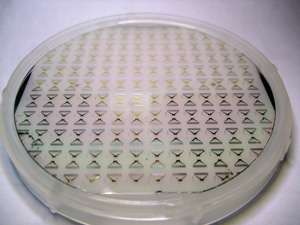Biosensor may improve clinical diagnosis of influenza A

Sensors based on special sound waves known as surface acoustic waves (SAWs) are capable of detecting tiny amounts of antigens of Influenza A viruses. Developed by A*STAR researchers, the biosensors have the potential to detect viral infections rapidly and reliably at the point of care, making them powerful tools for combating future pandemics.
Influenza, for most of us, is associated with a high fever and a few days in bed, but some forms of the disease can be deadly ― in 2010 two per cent of deaths in the United States were influenza related. Of the three strains of influenza viruses ― Influenza A, B and C ― it is Influenza A that gives rise to major pandemics that break out periodically. Therefore, it is essential to be able to rapidly distinguish between the more dangerous Influenza A and the other, more benign strains.
Current influenza detection methods have their limitations. "Of the two conventional methods for detecting Influenza A, one is nonquantitative, not specific enough, and often unreliable and inconclusive, whereas the other is time-consuming, expensive and requires trained professionals," explains Kui Yao of the A*STAR Institute of Materials Research and Engineering in Singapore.
To provide a better detection method, Yao and his co-workers produced their sensors (see image) by coating lithium niobate, a piezoelectric material, with silicon oxide. They then formed a bioactive surface by immobilizing Influenza A antibodies on the sensor.
The SAW response of the sensor changed when antigens of Influenza A bound to the immobilized antibodies on the sensor surface. Thus, by monitoring the SAW signal of a sensor, typically at very high frequencies of hundreds of megahertz, the researchers were able to detect antigens with a sensitivity of at least one nanogram per milliliter.
This is the first time that a SAW-based biosensor has been used to selectively detect targeted Influenza A antigens by immobilizing Influenza A antibodies.
"These results indicate the potential of using SAW sensors to detect libraries of pathogens and to further act as a cost-effective platform for rapid clinical diagnosis," says Yao.
The simplicity of such SAW sensors, and their ability to be mass produced, make them highly attractive. "Our SAW sensors have a high sensitivity and are quantitative, low cost and easy enough to be potentially used at clinics," says Yao.
In the future, the team hopes to further improve the sensor's design and performance and to use it to measure clinical samples by collaborating with doctors.
More information: SAW sensor for Influenza A virus detection enabled with efficient surface functionalization. Sensors and Actuators B: Chemical 209, 78–84 (2015). dx.doi.org/10.1016/j.snb.2014.11.103



















